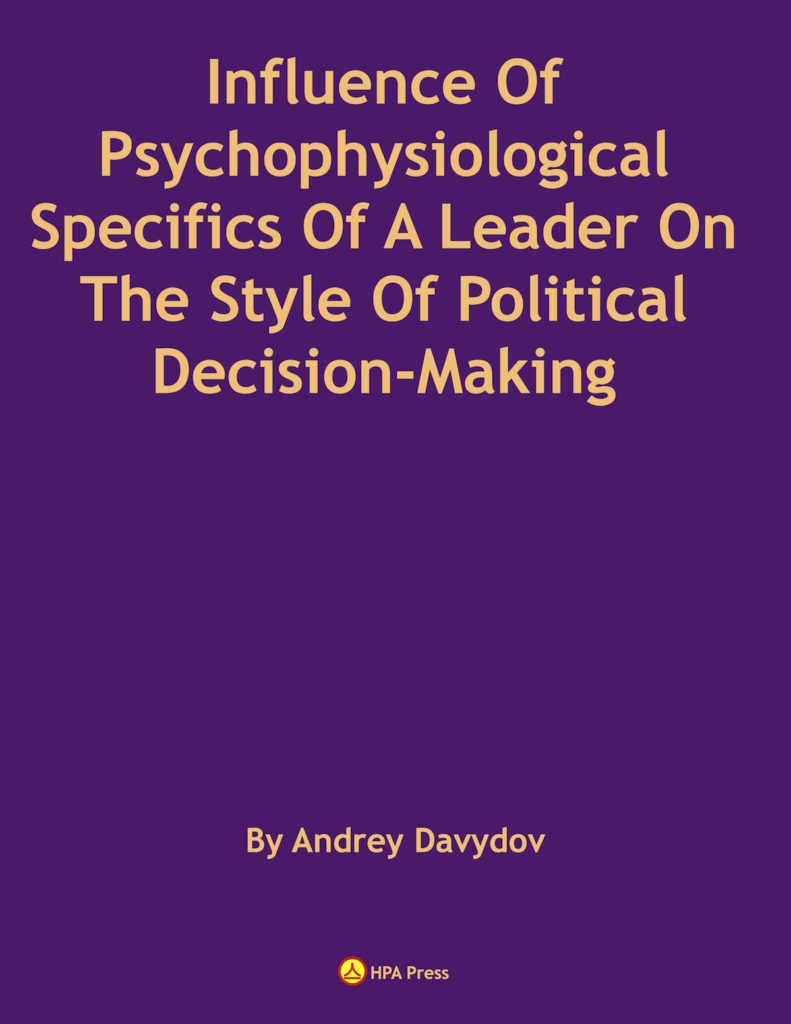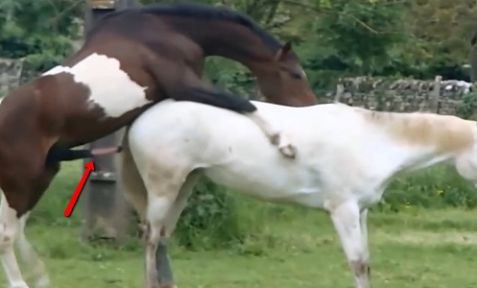
ISBN: 9781310104558
(Purchase an eBook or an AudioBook in English or in Russian.)
Influence Of Psychophysiological Specifics Of A Leader On The Style Of Political Decision-Making
Andrey Davydov
Translated by Kate Bazilevsky
Table Of Contents
Introduction
Culture Of A Symbol
“Personal Unconscious”
Pythagorean Approach In The Theory Of Personality
Conclusions
Bibliography
Introduction
Humanity is accustomed to feeling mature; despite the fact that compared to geomorphological age it is far from it, to put it mildly. Based on this comparison, we can conclude that we are still in childhood state. Maybe to some extent it is due to this that the current level of sensible activity of a human is not free from many natural laws, which often get ignored by theories of knowledge.
Culture undoubtedly includes rules for executions of cogitative operations, interpretations of events, and linking between them. To a great extent these rules determine the worldview inherent in a human. However, this picture has stable central cores, which usually do not change, even despite their apparent inconsistency with requirements of the environment, and these main cores form during very early stages of childhood. One of these cores is a symbol.
Plato, Pythagoras used the term “symbol” and even Homer mentions this word. In his perspective on a symbol, Aristotle ascended to views of his predecessors.
In our own time, we encounter a phenomenon of symbolization, symbolic view and description of the world, as something that is genetically inherent in unconscious structures of the brain. Consequently, a symbol is regarded as a product of symbolic representation of structures of the unconscious.
C. Lévi-Strauss stated that myth structure corresponds to structure of the unconscious (meaning that it reflects the mentality of people who are consciously aware of this myth), and also that cultural phenomena are external expressions of “I,” which manifest in the form of symbols and signs.
Philosophy, culturology denotes a series of questions, one of which can be formulated as follows: who is the author of a myth? C. G. Jung has shown that myth creation, as a non-reflexive activity of consciousness relates to the sphere of “collective unconscious.” His ideas about heritability of “collective unconscious,” the concept of “an archetype” as a great-symbol, as well as the idea that “cultural symbols are important components of our mental apparatus.” Another posing of the question was done by E. Cassirer: “If any culture consists of creation of spiritual images of the world, then the goal of philosophy is not to go beyond all these creations, but rather to understand and become consciously aware of the principle of their formation.” According to Cassirer, culture is generation of all possible new symbols, and therefore the task of cultural studies, as a philosophical discipline, is to construe these symbols, their essential meaning in order to identify their origin. This origin lies in the general transcendental symbolic function of consciousness itself. Symbolic function of consciousness is manifested as symbolic forms, or (and, it is the same thing) in the form of language, myth, religion, art, and science.
Some answers can be found in C. G. Jung’s “depth psychology,” namely, in his theory of “collective unconscious” that gave science the concept of “an archetype.” Jung states that collective unconscious is identical in all people. This leads to the thought of suprapersonal nature of collective unconscious. However, this does not exclude the thought of individual unconscious and individual archetype, as well as the archetypal complex in the system of collective and individual unconscious. And, that they are that pivot point for an individual, which allows it to have him to have his own individual behavioral style. …
To read more purchase in English or in Russian.
Bibliography
Windelband, B. (1910). Filosofiya kul’tury i transtsendentalnyy idealizm [Philosophy Of Culture And Transcendental Idealism.]. Moscow: Tip. “Pechatnoye Delo.”
Rickert, H. (1911). Nauki o prirode i nauki o kulture [Natural Sciences And Cultural Sciences.]. St. Petersburg: Obrazovaniye.
Goethe, J. W. (1964). Izbrannyye filosofskiye proizvedeniya [Selected Philosophical Works.]. Moscow: Nauka.
Kant, I. (1965). Soch. v 6-ti t. [Comp. in VI Vols.]. Moscow: Mysl.
Hegel, G. W. F. (1969). Estetika. Soch. v 4-kh t. [Aesthetics. Comp. in IV Vols.]. Moscow: Iskusstvo.
Kravchenko, A. (1970). Kassirer ob iskusstve kak simvolicheskoy forme [Cassirer On Art As A Symbolic Form.]. Moscow: Nauka.
Abramova, A. Z. (1972). Drevneyshiye formy izobrazitelnogo tvorchestva [The Most Ancient Forms Of Visual Art.]. Moscow: Iskusstvo.
Averintsev, S. S. (1972). Analiticheskaya psikhologiya K.G.Yunga i zakonomernosti tvorcheskoy fantazii [C. G. Jung’s Analytical Psychology And Patterns Of Creative Imagination.]. Moscow: Iskusstvo.
Stolyar, A. D. (1972). O genezise izobrazitelnoy deyatelnosti i yeye roli v stanovlenii soznaniya [On Genesis Of Visual Activity And Its Role In Development Of Consciousness.]. Moscow: Iskusstvo.
Losev, A. F. (1976). Problema simvola i realisticheskoye iskusstvo [The Problem Of The Symbol And Realist Art.]. Moscow: Iskusstvo.
Tahoe-Godi, A. A. (1980). Termin “simvol” v drevnegrecheskoy literature [The Term “Symbol” In The Ancient Greek Literature.]. Moscow: Izd-vo MGU.
Vasileva, T. Y. (1980). Problema germenevticheskogo metoda v sovremennoy burzhuaznoy filosofii [The Problem Of Hermeneutic Method In Modern Bourgeois Philosophy.]. Filosofskiye nauki.
Bulatov, M. A. (1983). Kategorii filosofii i kategorii kultury [Categories Of Philosophy And Categories Of Culture.] Kiev: Nauk. dumka.
Filosofskiy entsiklopedicheskiy slovar [Philosophical Encyclopedic Dictionary.]. (1983). Moscow: Sovetskaya entsiklopediya.
Ivanov, V. V. (1983). K. Levi-Stross i strukturnaya teoriya etnografii [C. Lévi-Strauss And Structural Theory Of Ethnography.]. Moscow: Raduga.
Lévi-Strauss, C. (1983). Strukturnaya antropologiya [Structural Anthropology.]. Moscow: Nauka.
Meletinsky, E. M. (1983). Mifologiya i folklor v trudakh K. Levi-Strossa [Mythology And Folklore In The Works Of C. Lévi-Strauss.]. Moscow: Nauka.
Turner, B. (1983). Simvol i ritual [Symbol And Ritual.]. Moscow: Nauka.
Aristotle (1984). A. I. Dovatur (Ed.). Soch. v 4-kh t. [Comp. in IV vols.]. Moscow: Mysl.
Bell, D. (1986). Sotsialnyye ramki informatsionnogo obshchestva [Social Framework Of The Information Society.]. Moscow: Progress.
Novikov, M. P. (Ed.). (1986). Ateisticheskiy slovar [Atheistic Dictionary.]. Moscow: Politizdat.
Filosofskiy slovar [Philosophical Dictionary.]. (1987). Moscow: Politizdat.
Gadamer, H. G. (1988). Istina i metod: Osnovy filosofskoy germenevtiki [Truth And Method: The Basics Of Philosophical Hermeneutics.]. Moscow: Progress.
Batkin, L. M. (1989). Italyanskoye Vozrozhdeniye v poiskakh individual’nosti [Italian Revival In Search Of Individuality.]. Moscow: Nauka.
Freud, S. (1989). Psikhologiya bessoznatelnogo [Psychology Of The Unconscious.]. Moscow: Prosveshcheniye.
Svasyan, K. L. (1989). Filosofiya simvolicheskikh form E. Kassirera [E. Cassirer’s Philosophy Of Symbolic Forms.]. Yerevan: Izdatelstvo AN Armyanskoy SSR.
Losev, A. F. (1991). Logika simvola [The Logic Of The Symbol.]. Moscow: Polit. lit.
Losev, A. F., Meletinskii, E. M., Riftin, B. L., Toporov, V. N., Ivanov, V. V., Averintsev, S. S., … Afanasyeva, V. K. (1991). S. A. Tokarev (Ed.). Mify narodov mira [Myths of the World] (Vols. 1-2.). Moscow: Sovetskaya Entsiklopediya.
Rakitov, A. I. (1991). Filosofiya kompyuternoy revolyutsii [Philosophy Of The Computer Revolution.]. Moscow: Politizdat.
Rubtsov, N. (1991). Simvol v iskusstve i zhizni [Symbol In Art And Life.]. Moscow: Nauka.
Sovremennaya zapadnaya filosofiya: slovar. [Modern Western Philosophy. Dictionary.]. (1991). Moscow, Politizdat.
Hall, M. P. (1993). Entsiklopedicheskoye izlozheniye masonskoy, germeticheskoy, kabalisticheskoy i rozenkreytserovskoy simvolicheskoy filosofii [Encyclopedic Outline Of Masonic, Hermetic, Qabbalistic, and Rosicrucian Symbolical Philosophy.]. Novosibirsk: VO “Nauka”, Sibirskaya izdatel’skaya firma.
Heidegger, M. (1993). Raboty i razmyshleniya raznykh let [Works And Thoughts Of Different Years.]. Moscow: Gnozis.
Kerlot, K. E. (1994). Slovar simvolov [Dictionary Of Symbols.]. Moscow: REFL-book. ISBN: 5879830144
© 2003 A. Davydov.
Translation © 2014 K. Bazilevsky.
All rights reserved.






